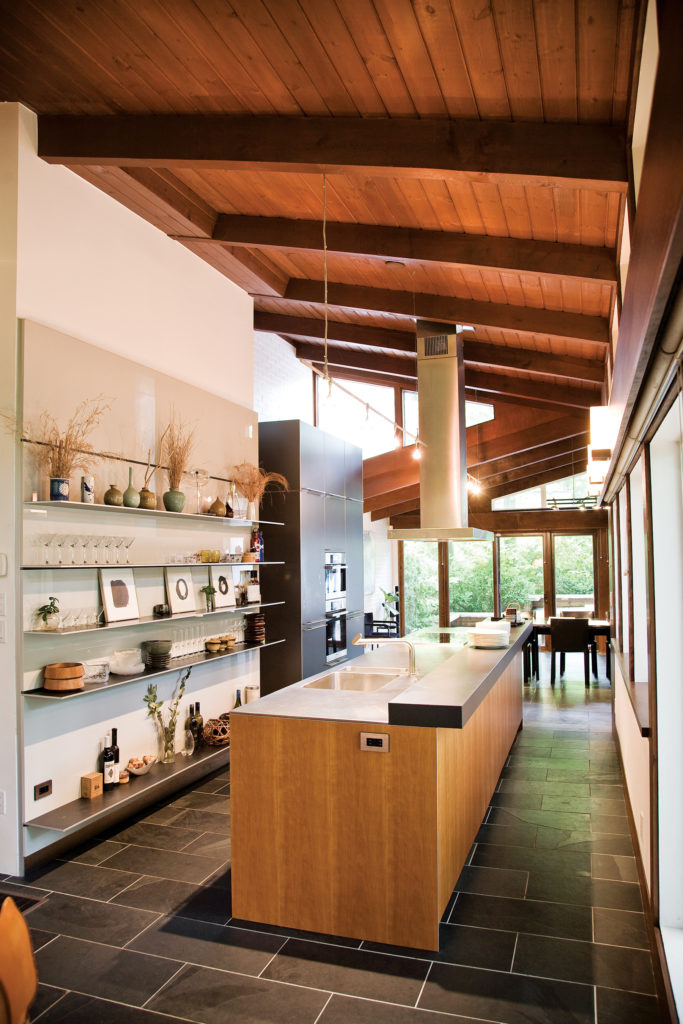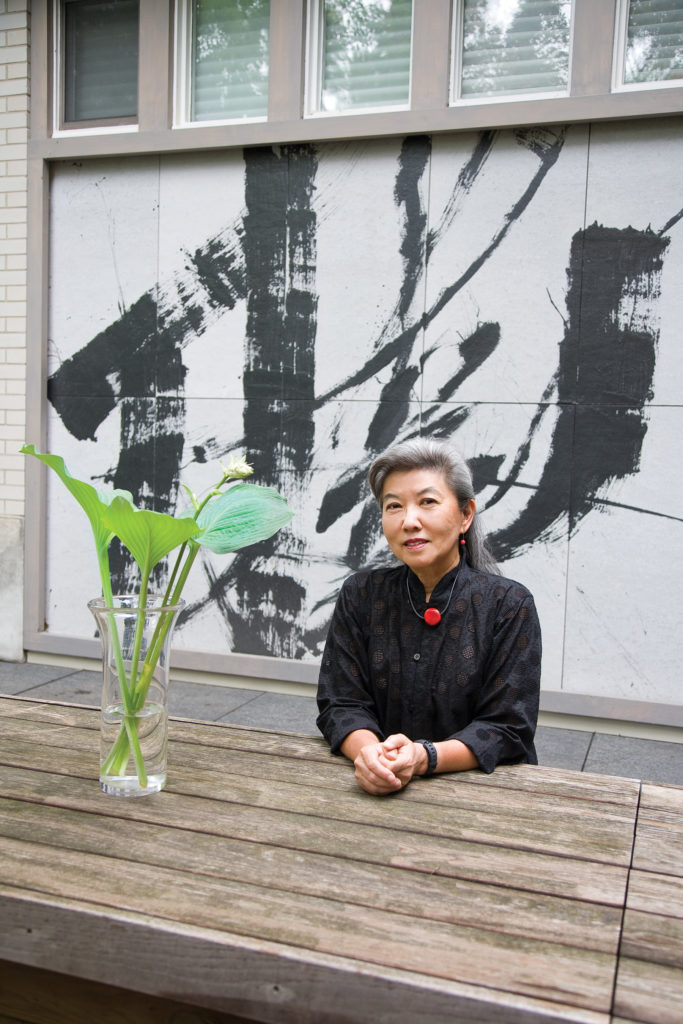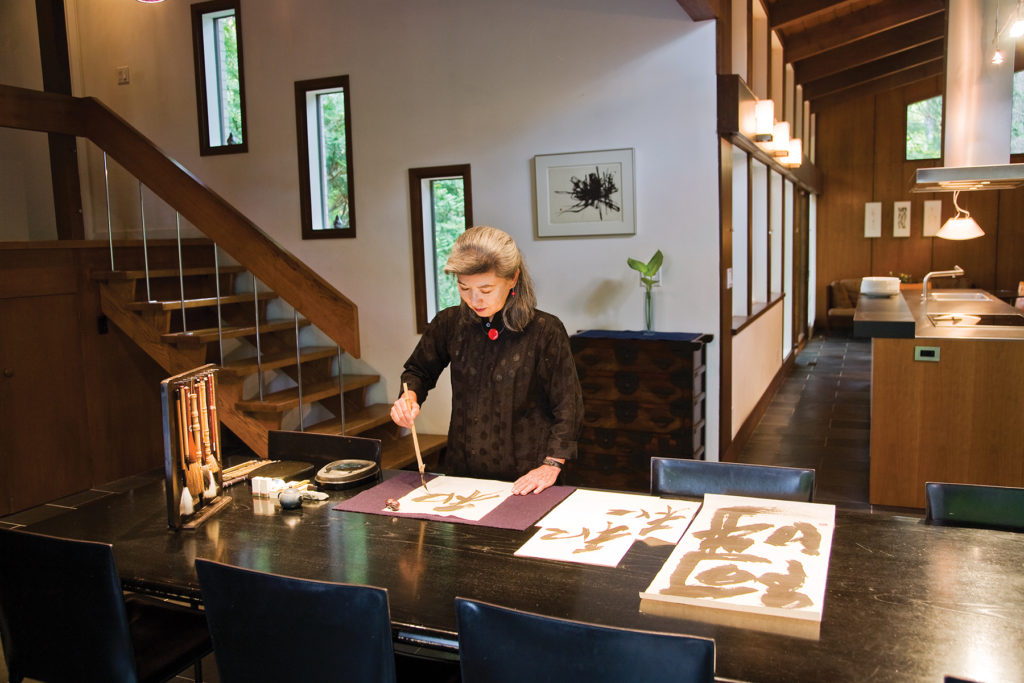
Artist Noriko Maeda’s wonderful home in the woods and her calligraphy share same reverence for unoccupied space
By Kathy Renwald
Noriko Maeda wears a flowing black dress, similar to a graduation robe, and red shoes as sculpted as ballet slippers as she greets me at her Waterloo home.
We stand for a few minutes in a space she terms the grey zone, a space that belongs to both the outside and the inside. It is airy and plain with a random flagstone floor, where shoes are removed in the Japanese way.
A covered walkway leads to the front door. Long, shallow stairs are lined on one side by bundles of kindling and open on the other to a shady, cool garden.
“It’s very Japanesey, ” Maeda says with a lilting laugh. “You are protected from the rain or the snow, it’s practical.”
Maeda is a Japanese contemporary calligrapher, and her broad portfolio shows the breadth of her talent. The simplest way to explain what she does is to explain what she doesn’t do: “I don’t write wedding invitations.”
She teaches, she has gallery shows, does commission work, and particularly loves to work with companies on calligraphy that expresses their image.
“My specialty is working with architects, ” she says.
Her work can be found on Sake bottles, Shiseido cosmetics, in the lobby of the Hyatt Regency in Tokyo and on the signage in the new addition to the Japanese Cultural Centre in Toronto. She is currently working with a hospital in Japan on calligraphy for a cancer treatment waiting room.
Studying calligraphy is an essential part of education in Japan. Maeda fell in love with the art when she was 10 and continued to study intensely, learning how to move the brush, work with ink, and always admire, appreciate and respect her teachers. After graduation she worked as both a copywriter and calligrapher in Tokyo, using words and her brush to express ideas.
Her work, also called Shodo, is expressive but spare, modern and contemplative. It is a language expressed in black, white and grey that most of us don’t understand. There are symbols or characters, some specific, some not. It is an ancient art where the blank space is as important as the brush stroke.
“You have to understand the void, ” she says.

Her wonderful home in the woods would seem to be the perfect place to display her art. There are a few pieces on view, but the house has the same reverence for unoccupied space that underpins her calligraphy.
Maeda moved from Japan to Waterloo in 1992. With her husband, Haruki, they raised two daughters, Natsuki and Sarara, in this house.
It was designed in the 1960s by architect Sherman Wright who, with the firm Jenkins & Wright, also designed the site plan and some early buildings for Waterloo College, which became Wilfrid Laurier University. Maeda’s Waterloo home was Wright’s only residential project.
“He designed it for himself when he was very interested in Japanese culture, ” Maeda says. The house faces southeast, a position of good luck in Japan. Odd numbers also play a role in good fortune, so the windows are placed in groups of three, five and seven.
“When we moved in, my daughter looked around at the windows that go to the ceiling and said, ‘We can enjoy the moon in many places.’ ”
The house has a good flow. It can be seen in Maeda’s movements as she appears to float from room to room, with her black dress swaying like a dancer’s.
We pass through the living room, home to a grand piano, a table full of orchids and big cushion stools that face a wall of windows. We sit at a small glass table lit by a suspended fixture with the fluid lines of a sail. The table faces a narrow deck that seems to disappear into the woods.
“My daughter (Natsuki) and her husband are architects in New York and they designed this (deck), ” Maeda says. “Their idea was the boardwalk into the ocean. It is very plain and imaginative. You can imagine not only a boardwalk, but someone’s Japanese Zen garden or your mother’s striped T-shirt. It is simple, and it expresses a void. That is a part of calligraphy too.”
From the little table with the view of the boardwalk, Maeda moves to the other side of the house where glass doors look out to a picnic-style table, partially sunken into the patio, as one might find at a Japanese restaurant. It offers a view of a work by Maeda painted on an exterior wall.
She worked with her architect daughter on the design. At first Maeda was thinking of soft and delicate lines. She sent sketches to Natsuki in New York.
“Rejected, rejected, rejected, ” Maeda says with a laugh. “My daughter said, ‘Mother, this wall faces a big tree, we need boldness, strength. This character of yours is talking to the tree, that conversation is important.’ ”
It’s not the easiest thing for an artist to take rejection, to have their ideas discarded, but Maeda seems to thrive on collaboration, while still advancing her ideas firmly.
That was evident in the story she tells about the redesign of her kitchen. It is the only room that has been changed in the house, a sign of how much the family respects the original design.
The original galley kitchen was just a little too small for a woman who loves to cook and entertain. Guests were invading her space. At one point as we talk, she even takes me by the shoulders and directs me to the other side of the counter away from the work triangle of sink, stove and refrigerator.
Maeda worked with the German company Bulthaup on the kitchen design. Antje Bulthaup, the granddaughter of the company’s founder, came to Waterloo from the company’s Toronto office just to watch Maeda cook. She wanted to see how Maeda moved.
“She even asked me if I cooked a turkey. When I said no, she was very happy I didn’t need a big oven and they could design an efficient, beautiful small kitchen.”
A new island with cherry veneer and stainless-steel countertop was built with dimensions that protected the chef’s space and made a corridor for guests. A floating cabinet holds the microwave and oven. Five stainless-steel shelves display glasses, a grouping of Maeda’s framed calligraphy and vases with cuttings from the garden, selected with her guest in mind.
“I knew that you liked gardens, ” she tells me. “So I ran outside and collected hosta leaves and hydrangeas and flowers.”
At a big table where she teaches her students, she demonstrates the graceful movements of her brush work. Light from the garden washes across her hands as she shuffles pages of work that formed her recent book, “Noriko Maeda: Foundations.”
“This is wind, this is waves, you see it moves off the paper; the white space is as important as the black.” The strokes are bold, strong and sometimes wispy when she uses feathers or twigs to make marks. Canadian nature informs her work.
She describes a visit to Yellowknife where she absorbed the views around Great Slave Lake. The vastness of white, the lines made by the shifting ice. These enlightening moments she depicts in her calligraphy.
“I used to be a city girl, but here I listen to the sound of snow.”
Her schedule is full, between teaching, commission work and working trips to Japan. She’s also involved in the Japanese Calligraphy Competition at the Japanese Cultural Centre in Toronto in November.
Learning, teaching, observing, creating — it is the busy artistic life of Noriko Maeda.
I ask her when is the peak of a calligrapher’s career?
“When I die, that is my peak, ” she says.

